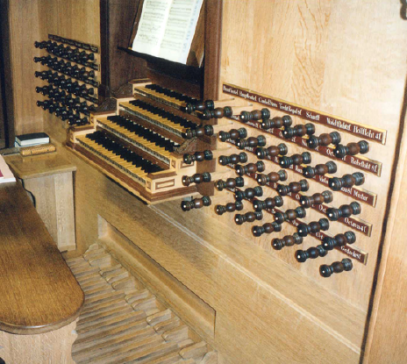


Hamburg, St. Jacobi
Arp Schnitger 1689-93, including older materials
State of preservation: Wind chests original, majority of pipes original; in storage during WW II, reset 1950, restored by Kemper in 1959-61 with a new case as a replacement of the original destroyed during WW II . In 1989-93 restoration by Jürgen Ahrend including a reconstruction of the western galleries resembling Schnitger's time. The organ case of oak was reconstructed following old depictions.
This organ is one of the most remarkable example of steady growth and change and renewal over centuries and generations. The oldest pipes still extant date from the new organ of 1512, itself having replaced an older instrument of 1443. Schnitger's organ was preceded by no less than about a dozen organ repairs, some of them renewals in part or completely within decades.
Schnitger used, as he often did, a considerable number of still useful ranks of his predecessors., here no less than 14 in parts or as a whole. 55 of 60 stops of Schnitger's times are still preserved; 3 front diapason ranks have been requisitioned in WW I and used in producing food tins.
The instrument, then the biggest in Hamburg, was visited by numerous musicians and organ players, among them Georg Friedrich Händel. In 1720 Johann Sebastian Bach applied for the position of organist but was neglected in favour of another candidate with sufficient benefits.
The Hamburg St Jacobi organ became, however, almost a holy relic for the early 20th century Orgelbewegung, the ideal instrument for the interpretation of Bach's organ works and those of previous organ composers. Scholars like Hans Henny Jahnn and organists like Günther Ramin, Karl Straube and Albert Schweitzer spread its fame as the "Bach organ" und founded an association of Bach's organ music and northern German organs.
Music sample
Musikbeispiel:
J.S. Bach : Fuge D-Dur (BWV 532)
played by Rudolph Kelber
Film
Specification
IV+P/60
HW:
Prinzipal 16’ (20th c.)
Quintadena 16’ (majority a1689)
Oktave 8’ (majority a1689)
Spitzflöte 8’
Viola da gamba 8’ (Lehnert 1760; before: Kammergedackt)
Oktave 4’
Rohrflöte 4’ (1512)
Superoktave 2’
Flachflöte 2’ (18th c. removal, new)
Rauschpfeife 2f.
Mixtur 6-8f.
RP:
Prinzipal 8’ (20th c.)
Gedackt 8’ (a1689)
Quintadena 8’ (a1689)
Oktave 4’
Blockflöte 4’ (majority a1689)
Quinte 22/3’ (a1689)
Sesquialtera 22/3’+13/5’ 2f. (majority a1689)
Oktave 2’
Sifflöte 11/3’ (majority a1689)
Scharff 6-8f. (a 1689)
Dulzian 16’ (possibly a1689)
Bärpfeife 8’
Schalmey 4’
OW:
Prinzipal 8’ (C-H new, original from c0)
Rohrflöte 8’
Holzflöte 8’
Oktave 4’ (majority a1689)
Spitzflöte 4’
Nasat 22/3’
Oktave 2’ (a1689)
Gemshorn 2’
Scharff 6f.
Zimbel 3f. (in Terzreihe)
Trompete 8’
Vox humana 8’
Trompete 4’
BW:
Holzprinzipal 8’ (a1689)
Oktave 4’ (a1689)
Hohlflöte 4’ (possibly a1689)
Sesquialtera 22/3’+13/5’ 2f. (a1689)
Waldflöte 2’ (a1689)
Scharff 4-6f.
Trechterregal 8’
Dulzian 8’
P:
Prinzipal 32’ (C-f#0 20th c.)
Oktave 16’
Subbaß 16’
Oktave 8’
Oktave 4’
Nachthorn 2’
Rauschpfeife 3f. (majority a1689)
Mixtur 6-8f. (a1689)
Posaune 32’
Posaune 16’
Dulzian 16’ (a1689)
Trompete 8’
Trompete 4’ (a1689)
Cornet 2’ (a1689)
Couplers RP/HW, OW/HW, HW/P, RP/P;
Zimbelsterne, Tremulants
© Greifenberger Institut für Musikinstrumentenkunde | info@greifenberger-institut.de





